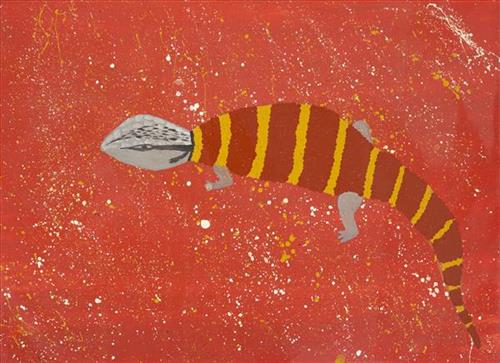111582211925
Lungkurta (blue tongue lizard)
Lungkurta (blue tongue lizard) are a species of short bodied, slender tailed skink, striped grey and orange with a distinctive blue tongue. Lungkurta are found throughout Australia in dry, sandy and stony areas. They hibernate in the cool months, emerging seasonally as temperatures warm in tuulparra (spring). Once dug from their burrows, lungkurta are usually seized by their tails as a way of preventing them from inflicting scratches or gashes. Traditional carved wana (digging-sticks) used to dig burrows have been replaced with metal bars, though burning and tracking techniques continue to be practiced in the hunting of lungkurta. Targeted waru (fire) clears vegetation and exposes burrows, whilst simultaneously providing diverse regenerating habitats for future lungkurta. When consumed, they are singed and then cooked in a coal and ash bed.
During the pujiman (traditional, desert dwelling) period, Martu would traverse very large distances annually in small family groups, moving seasonally from water source to water source, and hunting and gathering bush tucker as they went. Whilst desert life has moved away from mobile hunter-gatherer subsistence throughout the course of the twentieth century, bush tucker continues to be a significant component of the modern Martu diet. Hunting and gathering bush tucker remains equally valuable as an important cultural practice that is passed on intergenerationally. Though hunting and gathering implements have been modernised, methods of harvesting, tracking and the use of fire burning to drive animals from their retreats are still commonly practiced today.



